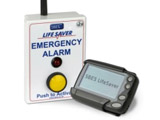 Peter Swan, MD of SBES, examines an often-overlooked issue
Peter Swan, MD of SBES, examines an often-overlooked issue
Lone working, which often takes place in isolated areas or at unsocial times, occurs across many different sectors including construction, labs, refineries, warehouses and data/server rooms. Safety of lone workers is vital for businesses, and employers have a responsibility to protect these workers, yet lone worker safety is an area that is often forgotten or neglected.
UK lone worker policy does not prohibit lone working in a general sense, but companies and organisations must conduct a risk assessment covering the activities of all employees, including lone workers. Since the Corporate Manslaughter and Corporate Homicide Act of 2007, companies and organisations can be found guilty of corporate manslaughter due to any serious management failure that results in a gross breach of their duty of care. A breach of the Act is likely to occur if organisations are not aware of the risks to their lone workers and/or if suitable protection is not in place.
As a first step, employers need to conduct risk assessments within lone working environments. The findings of the risk assessment can then be used as the basis for further measures. Such measures include correct supervision - someone should always be aware of where and when employees are working in isolated environments.
Over and above supervision, lone workers (like any other worker) should receive the appropriate training and equipment for all situations that could risk their safety. This applies even to those working in environments that appear ‘safe’. Data centres and server rooms, for example, can have hidden dangers such as high voltages, trip hazards and confined spaces (for example heating and ventilation ducts).
Lone worker protection equipment falls into two broad camps in terms of technology – those that rely on mobile phone technology, and those that rely on local wireless transmission. There are pros and cons to both. Those that rely on the mobile phone network, for example, require a good 3G or 4G network signal and good battery life, while those that use local wireless networks, such as a site based lone worker alarm system, do not suffer from signal ‘black-spots’ or outages.
Many lone worker protection systems use GPS which can locate an incident down to a few metres – great for outdoors but don’t be fooled GPS doesn’t work effectively indoors.
It is down to the individual employer to ensure the correct technology is installed to keep their lone workers safe. Often the risk for lone workers is too high to rely on the mobile phone network or GPS systems.
Another important factor to bear in mind are the strict European rules and regulations concerning explosive atmospheres (Explosive Atmospheres Directive 94/9/EC). All lone worker alarm systems must be ATEX/Ex certified to the correct Protection Zone, Apparatus Group and Temperature class for each individual ATEX/Ex environment. It is important to bear in mind that just because safety equipment holds an ATEX/Ex label, it may not be certified to the correct level required and offer the correct protection to lone workers.
Peter Swan, Managing Director, SBES: www.sbes.co.uk
SBES offers a comprehensive range of lone worker protection systems to help mitigate the risk of incidents involving lone workers.


